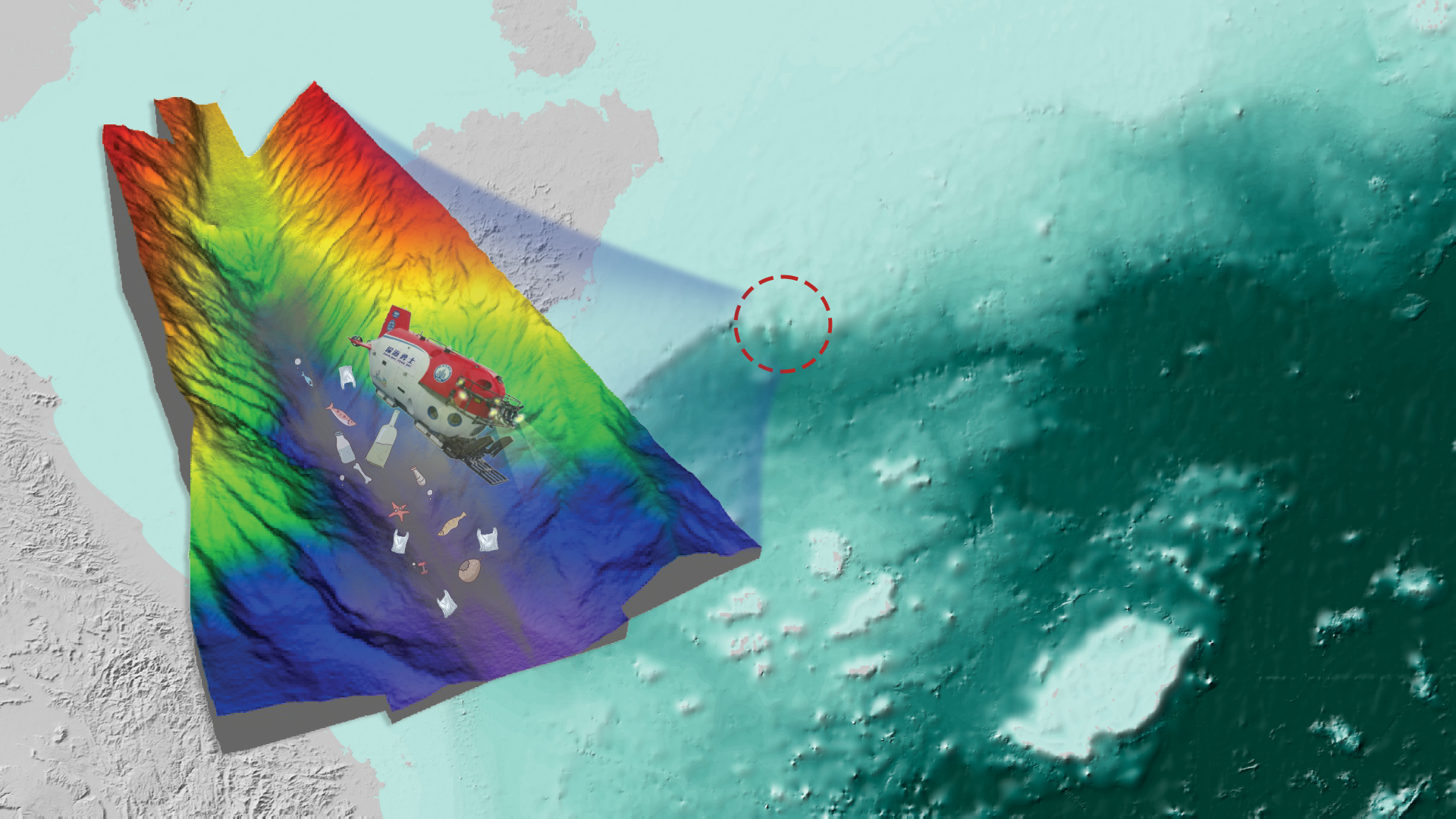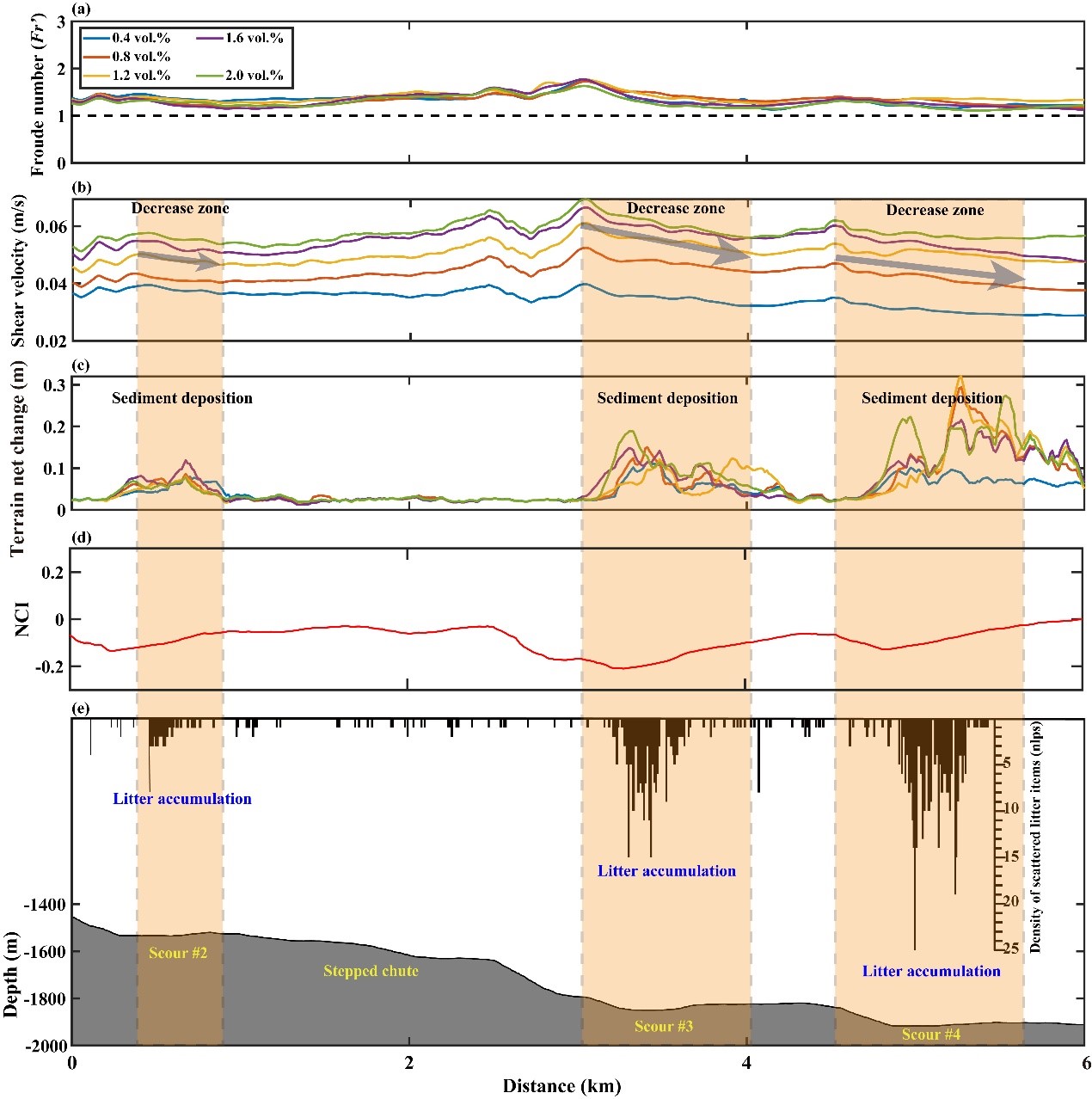The ever-increasing use of plastics has become a huge environmental problem, with plastic litter posing serious threats to ecosystems and human health. Both on land and in/beneath the ocean’s surface, plastic pollution has become a global concern among scientists, environmentalists, and governments at all levels. It’s estimated that over ten million tons of plastic litter enter the world’s oceans each year. While plastic debris is widespread on the sea floor, our understanding of the exact mechanisms behind its transport and deposition patterns in deep-sea environments remains poorly understood.
In the manned dives reported by Zhong and Peng (2021), plastic litter was found aggregated in a series of piles located in several scours along the floor of a submarine canyon in the northwestern South China Sea. The quasi-regular distribution of plastic piles was postulated to be a product of internal hydraulic jumps of turbidity currents flowing over these scours in the submarine canyon. However, the specific hydrodynamic process and resulting deposition behavior of turbidity currents flowing through this submarine canyon have not been thoroughly investigated. Consequently, it is hard to clearly establish the relationship between plastic litter accumulation and the hydrodynamic processes of turbidity currents flowing through this observed canyon floor bathymetry.

Professor Jingping Xu’s research group from the Department of Ocean Science and Engineering at the Southern University of Science and Technology, along with collaborators, has made significant strides in understanding material transport by turbidity currents in submarine canyons.
Their findings, titled “How does plastic litter accumulate in submarine canyons?”, have been published in the journal Geophysical Research Letters, which is indexed in the Nature Index for Earth Sciences.
To further investigate how plastic litter is transported and accumulated under the control of turbidity currents, the research team conducted 25 numerical simulations. These simulations examined the dynamics of turbidity currents in submarine canyons by calculating the Froude number, shear velocity, and the concavity of the seabed topography (Figure 1). The researchers integrated three-dimensional multibeam bathymetric data with observations of plastic litter distribution. Their in-depth study provided new perspectives into the turbidity current mechanisms responsible for plastic litter transport and accumulation in submarine canyons.
The following insights were gained: First, the high spatial overlap between the plastic litter accumulations and simulated turbidity currents deposits indicates that the plastic litter found in the scours may share the same sedimentary processes as the sediments in turbidity currents. Second, the rapid decrease in shear velocity of turbidity currents flow over topographies with greater concavity is the primary reason for the accumulation of plastic litter in these scours.

Figure 1. The hydrodynamic and depositional characteristics of turbidity currents within different concentration conditions. (a) The time-averaged Froude number. (b) Fluctuations of the time-averaged shear velocity. (c) The accumulated sediment deposition thickness resulted from the turbidity currents. (d) The concavity computed from the longitudinal profile of submarine canyon. (e) The corresponding litter density profiles along the 2018 dive track from Zhong and Peng (2021). nlps, number of the scattered litter items per snapshot.
This study reconstructed the dynamic and deposition processes of turbidity currents in the submarine canyon and proposed a new mechanism for the transport and deposition of plastic litter under the control of these currents. It deepens our understanding of the distribution patterns of plastic litter in the deep sea and provides a new perspective for studying accumulation patterns of plastic litter in other global submarine canyons. Additionally, it offers scientific evidence for addressing marine plastic pollution and managing plastic litter.
Ph.D. student Yuping Yang from Jingping Xu’s research group is the first author of the paper. Professor Jingping Xu is the corresponding author, while Researcher Dawei Wang from the Institute of Deep-Sea Science and Engineering at the Chinese Academy of Sciences is the co-corresponding author. The Department of Ocean Science and Engineering at SUSTech is the primary and co-corresponding institution for the paper.
Other contributors to this work include Professor Benjamin Kneller from the University of Aberdeen, Professor Guangfa Zhong from Tongji University, postdoctoral researcher Kaiqi Yu (currently an Assistant Researcher at the South China Sea Institute of Oceanology, Chinese Academy of Sciences), and former University College London graduate Minghan Wang.
Paper link: https://doi.org/10.1029/2024GL110767
To read all stories about SUSTech science, subscribe to the monthly SUSTech Newsletter.
Proofread ByAdrian Cremin, Yingying XIA
Photo ByDepartment of Ocean Science and Engineering